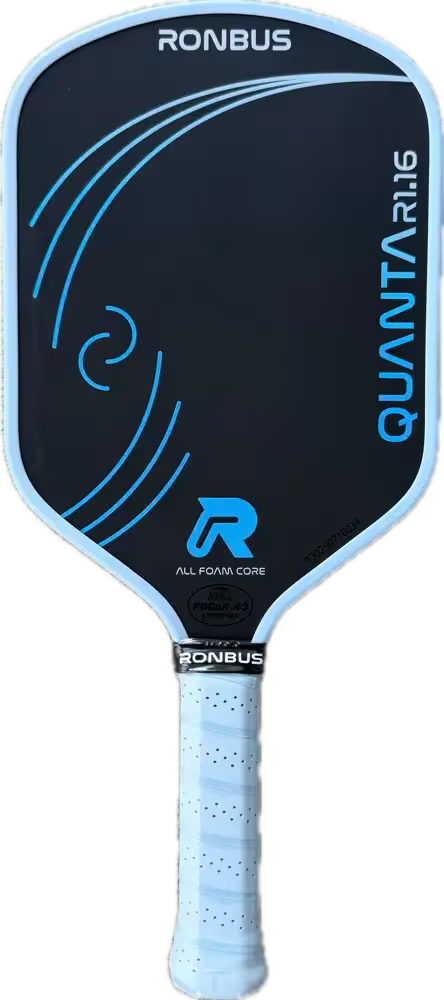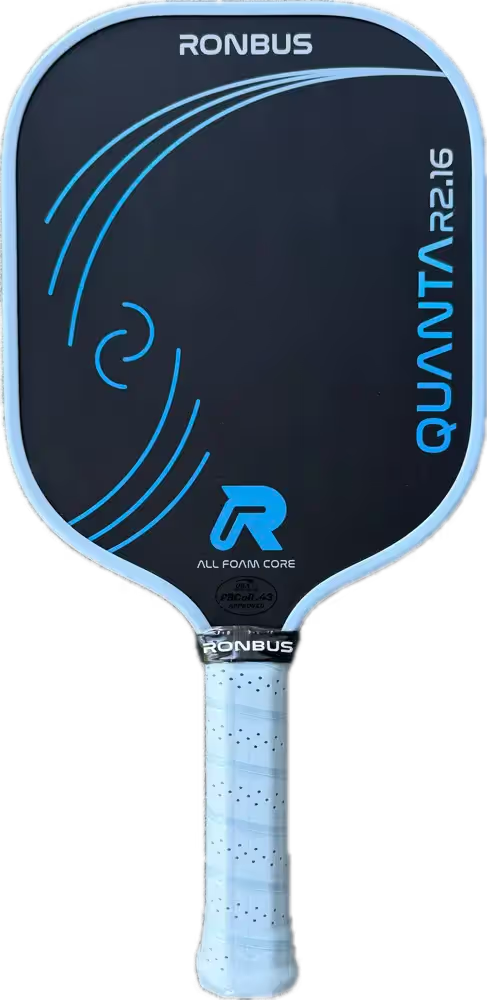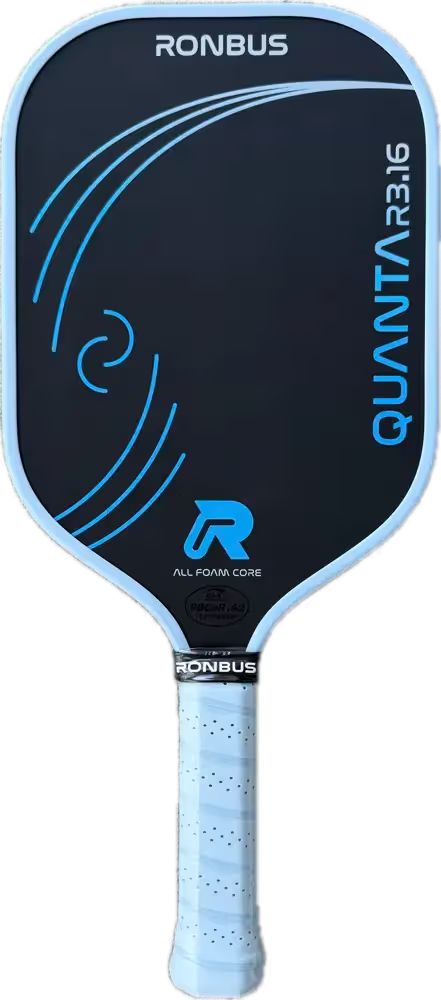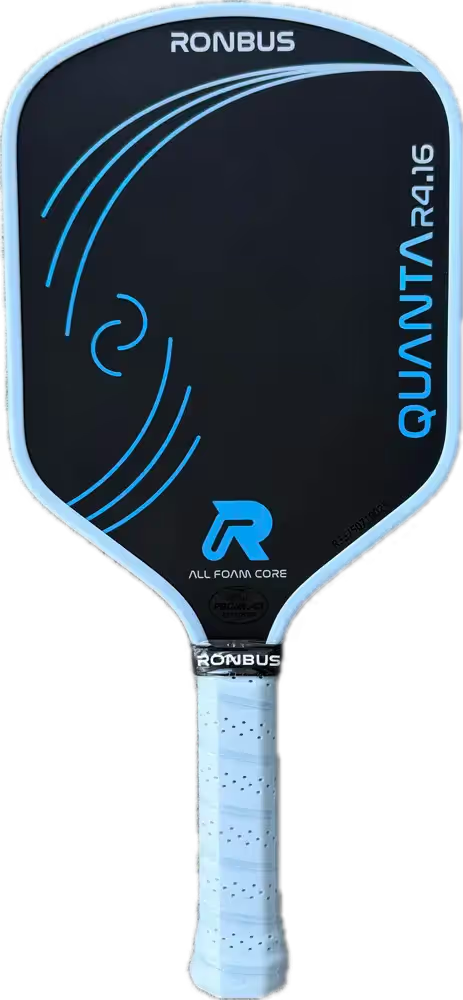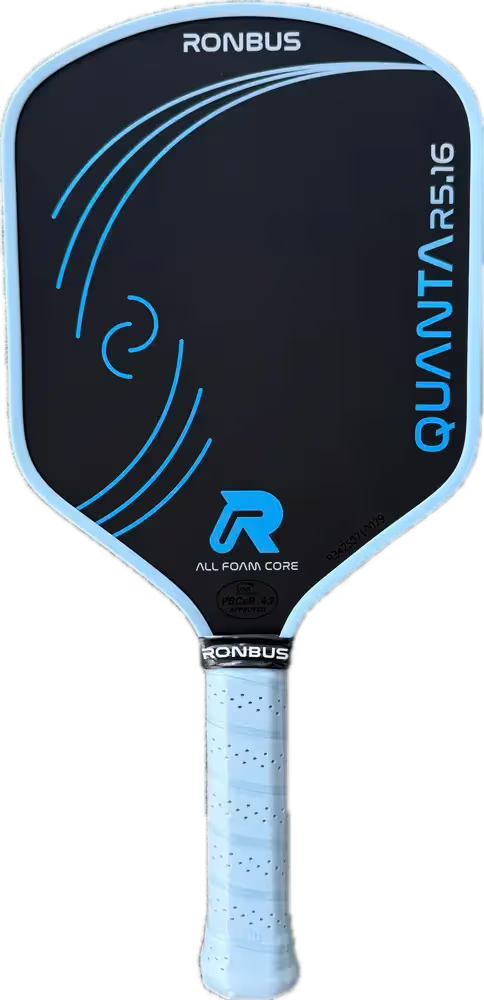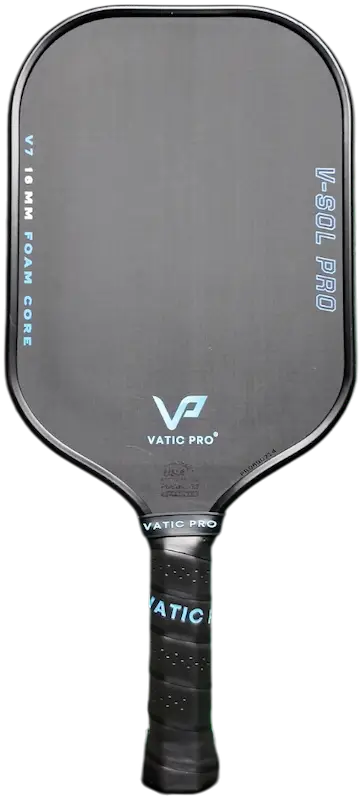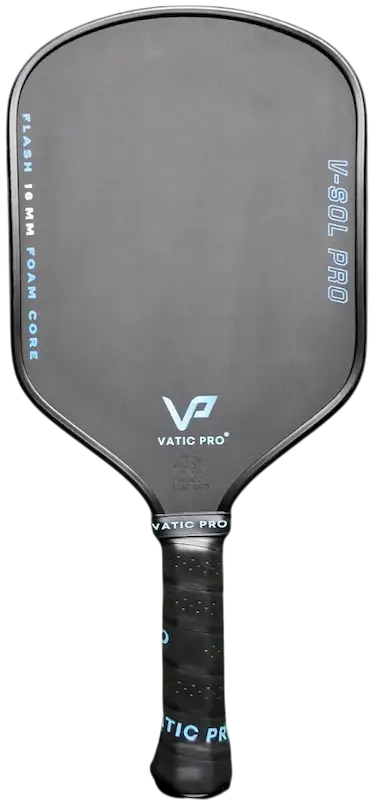TL;DR:
- Ships light (7.89 oz, 104 SW, 5.6 TW) but includes 18g tape kit for customization
- Full-floating EPP foam with EVA perimeter creates dense feel without honeycomb rebound
- With 12g added at position 2: 8.49 oz, 109 SW, 6.6 TW—stable and quick
- Strong spin generation from coarse peel-ply texture, good control once weighted
- $162 with code MPB—solid value if you're willing to tape and tune
Intro
Here's a paddle that comes with its own weighted tape kit because the company knows you'll need it. The Scoop Hellcat 1 delivers solid foam paddle performance once you dial it in, but stock it plays light and gets pushed around on mishits. I've been playing this for a few weeks and really enjoying how it performs with some strategic weight additions. The question is whether you're willing to customize right out of the box or if you'd rather pay more for something that works right away on day one.
Scoop sent me this paddle with nothing expected in return. No money changed hands, and they didn't ask for a positive review. I do have a discount code, MPB, that you can use to save 10% on your purchase. By using it, you'll earn me a small commission, which helps me continue producing content just like this.
What makes the Hellcat interesting is Scoop's transparent approach to what this paddle needs. They're not pretending it's dialed in stock—they ship it with 18 grams of pre-cut tungsten-silicone tape and a placement guide. For a brand founded in April 2024, this is a bold move: launching a foam-core paddle that asks players to participate in the tuning process rather than delivering plug-and-play performance.
Tech Overview
This is Scoop's first entry into foam-core construction, and it uses Gen 4 full-floating EPP foam with EVA perimeter foam concentrated in the top half. Scoop calls this a "diving board effect," and the construction creates a notably dense feel compared to honeycomb cores. The floating foam setup puts this paddle in the same category as the Honolulu Pickleball CF+, Bread & Butter Loco, and similar models that have gained traction with feel-based players. Interestingly, multiple testers initially thought the Hellcat was honeycomb based on how it feels and plays at contact, but X-rays confirm it's full floating foam throughout.
The face is triple-layer T700 raw carbon with peel-ply texture, thermoformed edges, and tick marks around the perimeter for even tape placement. The design is minimalistic all the way through. It's USAP approved at 0.43 PBCoR and measured at 0.42 in testing. The floating foam core feels denser than honeycomb without the immediate rebound of something like the Loco. The texture grabs well for spin, and the build quality appears solid with consistent edge bonding and no rattles or loose components after several weeks of play.
The tech differentiator here is the combination of floating foam density with EVA perimeter weighting that creates a specific balance profile. This isn't a paddle trying to maximize power or control out of the box—it's designed with headroom for customization. The tick marks and included tape kit aren't afterthoughts; they're core to Scoop's design philosophy. For context, Scoop Pickleball is based in Leonardtown, Maryland, and was founded by Alex Smolen with a focus on bringing high-quality, affordable paddles to the Southern Maryland community. All their paddle names draw from aviation, which tracks with Alex's background working on drones. The Hellcat represents their step into a market where new foam-core paddles launch constantly, and they've chosen to differentiate through customization accessibility rather than trying to be everything stock.
Specs
The Hellcat comes in one shape: elongated or nothing. At 16.5 by 7.375 inches with a 5.5-inch handle, you get the reach of an elongated frame without committing to high swing weight stock. My test paddle measured 7.89 ounces static, 104.35 swing weight, and 5.6 twist weight. The balance point sits at 23.1 centimeters. For reference, most paddles need a twist weight above 6.2 to play stable in stock form, so the Hellcat's 5.6 leaves it vulnerable to off-center hits without added weight.
That 104 swing weight makes this a quick-swinging paddle on paper, but the low twist weight means the sweet spot shrinks and mishits feel flimsy. This is where the included tape kit comes into play. Every Hellcat ships with 18 grams of pre-cut tungsten-silicone tape plus a placement guide. Location 1 at the top maximizes power. Locations 3 and 4 on the sides boost twist weight and stability. With 12 grams added at position 2, my test paddle transformed to 8.49 ounces static, 109.25 swing weight, and 6.6 twist weight. That's still light enough to swing quickly but stable enough to handle off-center contact without folding.
The specs tell you this paddle wants customization. If you're looking for plug-and-play performance, the stock numbers won't deliver. But if you're willing to add weight strategically, the Hellcat gives you a starting point that's quick and maneuverable with room to build stability without getting into heavy, fatiguing territory. Even at 109 swing weight with tape, this stays in the light-to-moderate range that most players can swing all day.
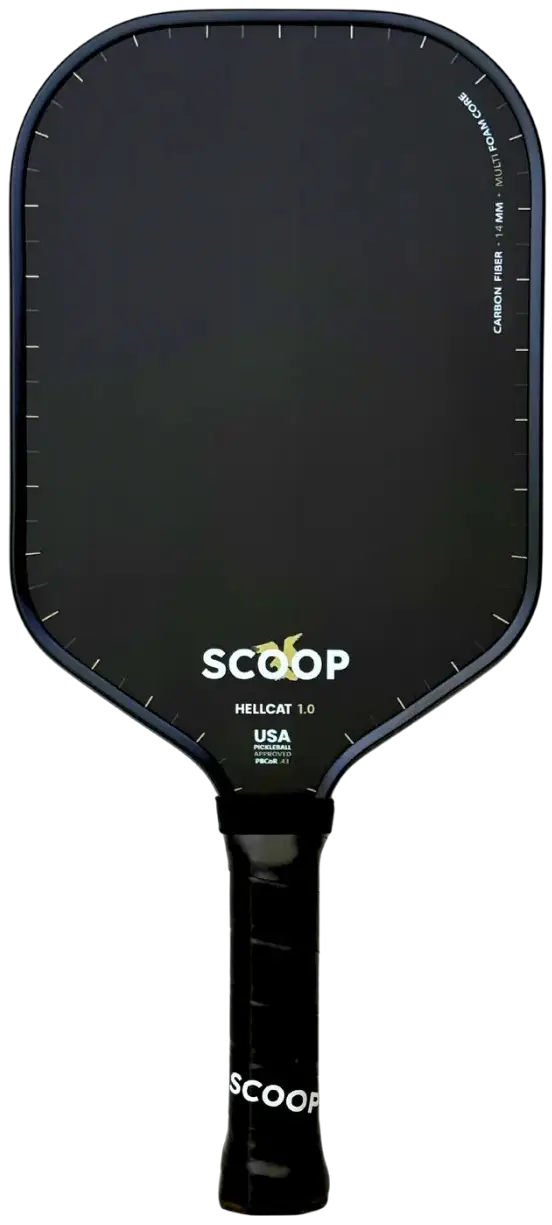
- Control
Best for strategic players who favor precision and placement over power, excelling in slow play and careful ball manipulation. - All-Court
Designed for versatile players who want the best of both worlds. These paddles balance control, power, and speed, adaptable to various playing styles. - Power
Ideal for aggressive players (aka, "bangers") who prioritize fast, powerful gameplay, sacrificing some control and sweet spot size for maximum force.


...
Playtest
Stock, the Hellcat plays quick at 104 swing weight but light on drives. The sound is loud—a solid crack in the Bantam family, but not as piercing as some of the loudest paddles on the market. The coarse peel-ply texture grabs well for spin generation. I could consistently shape balls and load spin into drives, drops, and rolls without much effort. The texture does the work, and the foam core provides enough dwell time to manipulate the ball through contact.
Control at the net is playable once you add weight. Stock, the paddle feels too light to plow through resets consistently, and off-center hits come off weak. The 5.6 twist weight stock creates a small sweet spot, and anything outside that center zone gets pushed around. Add 12 grams at position 2 on the placement guide, and everything transforms. The paddle stops getting pushed around, drives gain solidity, and even at 109.25 swing weight—which is still very light—it's a plenty quick swinging frame with noticeably improved stability.
The feel at contact is dense without being hollow. The floating foam core delivers a softer landing than honeycomb but doesn't have the immediate pop of paddles like the Loco. You get feedback through the handle that lets you know where you made contact, which helps with shot correction mid-rally. During fast exchanges at the kitchen, the weighted Hellcat holds up well. Blocks feel controlled, resets drop with enough spin to stay down, and hands battles don't feel like you're fighting with an unstable platform.
Depth control on drives improved significantly with added weight. With 12 grams added, depth and power came naturally. The paddle carries momentum through contact better, and mishits that would have died short started making it to the baseline. The elongated shape provides reach on wide balls and overhead clearance, but you give up some forgiveness on the edges compared to a standard or widebody shape. Even weighted, this wants reasonably clean contact to perform at its best.
Spin generation remained strong throughout testing. The peel-ply texture holds onto the ball long enough to load rotation without feeling sticky or grabby. Roll volleys came off with good action, and I could shape dinks with topspin or slice depending on what the point called for. The floating foam doesn't kill spin the way some dense cores can, and the combination of texture and dwell time makes this a solid option for players who rely on spin to create problems.
Shape Comparisons
The Hellcat comes in one shape, so there's no comparison between variants to discuss. You either like elongated paddles or you don't. The elongated format gives you reach advantages on wide balls and overheads, and the extra length helps generate leverage on serves and drives. The tradeoff is a narrower face width at 7.375 inches, which reduces edge forgiveness compared to standard or widebody options.
Multiple testers compared the Hellcat to the Honolulu FC+ and called it "the FC+ in 14mm." That comparison makes sense—both use floating foam construction, both deliver dense feel without honeycomb rebound, and both perform well once properly weighted. Others noted similarities to the Ronbus Quanta 16, which is accurate in terms of how light both paddles ship stock. The difference is that the Hellcat includes the tape kit, which gives you everything needed to dial it in without hunting for aftermarket solutions.
The Bread & Butter Loco came up as another comparison, though the Hellcat isn't as powerful. The Loco has more immediate pop and plays more aggressively stock, while the Hellcat leans more control-oriented once weighted. The sweet spot on the Hellcat sits center to slightly upper-center, which is typical for elongated shapes with EVA foam concentrated in the top half. If you're used to standard shapes with larger sweet spots, the learning curve here involves being more precise with contact points.
Recommendations
The Hellcat is built for players who want a fast, customizable elongated paddle that delivers premium performance once dialed in. This suits all-court players who lean toward power and reach but still need control at the net. If you appreciate how floating foam plays but want more density than honeycomb, the Hellcat delivers that specific feel profile. Players who enjoy the tuning and dialing process will appreciate getting everything needed for customization included in the box. If you're new to adding weight to paddles, the Hellcat provides a complete kit with clear guidance for learning the process.
Skip this if you dislike elongated paddles, prefer quieter options, or won't tape and tune. Even weighted, this wants reasonably clean contact, so players who struggle with consistency or those looking for maximum forgiveness should look elsewhere. If you want plug-and-play performance without customization, paddles like the Six Zero Double Black Diamond or ProXR Brawler 16 deliver stability stock without requiring immediate modifications.
For players comparing options in the foam category, the Hellcat sits between the FC+ and the Loco in terms of power and feel. It's more customizable than the FC+ stock and less aggressive than the Loco, which makes it a middle ground for players who want control without sacrificing too much power. The included tape kit is a real advantage compared to the Ronbus Quanta, which ships similarly light but doesn't provide weighting solutions in the box.
This paddle excels at generating spin on serves and third shots, maintaining depth on drives once weighted, and providing reach advantages during transition play. It's less ideal for pure touch players who prioritize soft hands and finesse over power and spin. The elongated shape and foam construction create a specific playing style that rewards aggressive shot selection and clean contact.
Price and Value
At $162 with code MPB, the Hellcat represents solid value in the foam paddle market. You're getting a full-floating foam construction with triple-layer T700 carbon face, thermoformed edges, and a complete 18-gram tape kit with placement guide. For comparison, the Honolulu FC+ runs around $180-200 depending on availability, the Bread & Butter Loco typically sells for $160-180, and the Ronbus Quanta 16 comes in around $160 but doesn't include weighting solutions.
The value proposition here is straightforward: you're paying mid-tier pricing for construction that rivals paddles costing more, with the caveat that you need to invest time in customization. If you're willing to add weight strategically, the Hellcat competes with paddles in the $180-220 range once dialed in. If you're not willing to customize, that $162 price point doesn't deliver the same value because the stock performance doesn't match the construction quality.
Build quality exceeds expectations for a brand that launched in April 2024. The thermoformed edges are consistent, the face texture is uniform across the hitting surface, and nothing felt loose or questionable after several weeks of play. Scoop doesn't manufacture in the U.S., but the quality control appears solid based on this test paddle. No warranty information was provided, so that's worth confirming before purchase if long-term support matters to your buying decision.
The included tape kit adds significant value. Aftermarket tungsten tape typically costs $15-25 for similar quantities, so you're essentially getting customization supplies bundled at no extra cost. The placement guide takes guesswork out of the process, which matters for players new to weighting paddles. If you were going to buy tape anyway, the Hellcat's price effectively drops to $140-150 when accounting for those included materials.
Conclusion
The Scoop Hellcat 1 delivers solid foam paddle performance for players willing to customize. The full-floating EPP foam core creates dense feel without honeycomb rebound, the peel-ply texture generates strong spin, and the build quality is consistent for a young brand. At $162 with code MPB and an included 18-gram tape kit, this represents good value in the foam category once you invest time in dialing it in. Stock performance is light and unstable, but with 12 grams added at position 2, the paddle transforms into a stable, quick-swinging frame that competes with options costing more.
This paddle is best for all-court players who want elongated reach, appreciate floating foam construction, and enjoy the tuning process. If you prefer plug-and-play performance or maximum forgiveness, look elsewhere. The Hellcat rewards clean contact and strategic customization, which makes it ideal for tinkerers and players who want control over their equipment's final performance profile.
The paddle is available now at scooppickleball.com, and code MPB saves 10% off your purchase. Drop your questions in the comments below, and if this review was helpful, consider sharing it with other players looking for honest paddle assessments. For more detailed paddle breakdowns and performance analysis, subscribe to the newsletter and follow along on YouTube for the latest reviews and testing updates.
Discount Code


%20(1100%20x%20220%20px)%20(1000%20x%20300%20px)%20(1).webp)











